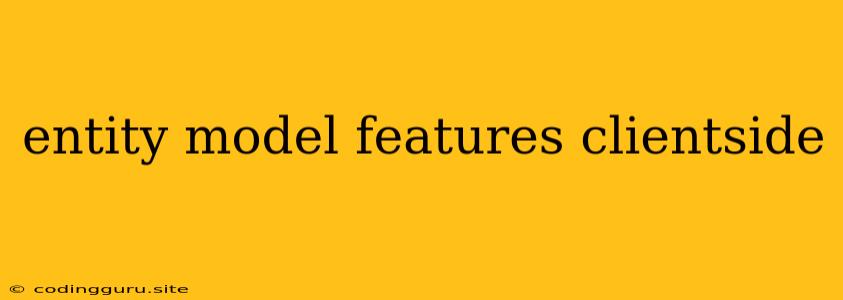Understanding Entity Models: A Client-Side Perspective
In the realm of software development, especially within the context of web applications, entity models play a crucial role in defining and structuring data. But what exactly are they, and how do they impact the client-side experience?
Let's delve into this fundamental concept, exploring its importance, features, and how it interacts with the front-end of a web application.
What is an Entity Model?
An entity model, in essence, is a representation of real-world entities within a software system. These entities can be anything – a user, a product, a blog post, an order, or even a complex system like a car. The model acts as a blueprint, dictating the attributes and relationships of each entity.
Imagine building a simple e-commerce website. You would need models for products, customers, and orders. Each model would define attributes like:
- Product: name, description, price, image, category, etc.
- Customer: name, email, address, order history, etc.
- Order: order ID, customer ID, products, total price, order date, etc.
Importance of Entity Models for Client-Side Development
While entity models are typically associated with server-side development, they have a significant impact on the client-side experience. Here's why:
- Data Consistency: Models ensure uniformity in how data is structured and accessed throughout the application. This consistency is crucial for smooth operation and data integrity, regardless of where the data is being processed – server or client.
- Efficient Data Handling: By providing a defined structure, entity models make it easier for developers to manage and manipulate data on the client-side. They offer a clear understanding of data fields, relationships, and potential data transformations.
- Simplified Data Transfer: Models act as a bridge between the server and the client. They facilitate smooth data transfer, ensuring the client receives data in a format it can readily understand and process.
- Enhanced User Interface: Entity models enable the development of intuitive user interfaces. They provide the basis for building forms, lists, and other interactive elements that effectively represent and manipulate data based on the defined model structure.
Features of an Effective Entity Model
A well-designed entity model should possess several key features:
- Simplicity: Models should be straightforward to understand and use. Avoid unnecessary complexity and ensure clarity in defining relationships and attributes.
- Flexibility: Models should accommodate future changes and additions to the data schema. This adaptability ensures that your application can evolve alongside your data needs.
- Consistency: Maintain a consistent approach to naming conventions and data types across your entity models. This consistency improves code readability and maintainability.
Client-Side Interactions with Entity Models
On the client-side, entity models primarily influence how data is:
- Retrieved: Data retrieved from the server, often in JSON format, is often transformed into client-side objects based on the defined entity model.
- Processed: Client-side logic manipulates and transforms data based on the structure and relationships outlined in the entity model.
- Displayed: User interfaces are designed and rendered using the data retrieved from the server and structured by the entity model.
Example: A Simple Blog Application
Let's consider a basic blog application. The entity model would define:
- Post: title, author, content, publish date, category.
- User: username, email, password.
On the client-side, this model would influence:
- Displaying posts: A list of posts would be rendered dynamically, extracting information like title, author, and publish date from each post object.
- User interaction: A form for creating a new post would be constructed based on the attributes defined in the Post model.
Conclusion
Entity models play a critical role in shaping the client-side experience of web applications. They establish a clear structure for data, ensure consistency across the application, and facilitate efficient data handling and display. By carefully considering and implementing effective entity models, developers can build robust and user-friendly web applications that are both data-driven and user-centric.
